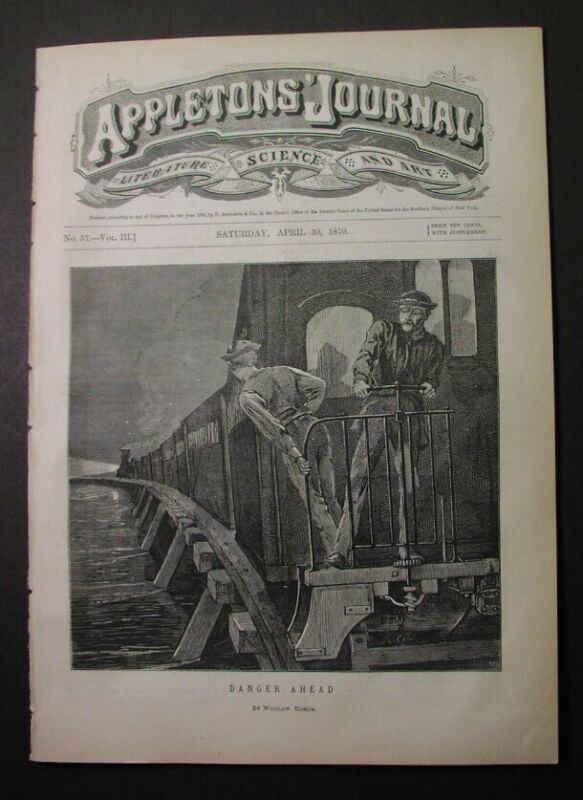-40%
WINSLOW HOMER: "Danger Ahead" -1870 RAILROAD engraving; heroic brakeman; Agassiz
$ 10.53
- Description
- Size Guide
Description
wood engravingby
WINSLOW HOMER
“Danger Ahead”
April 30,
1870
This is a full issue of
Appleton’s Journal
which features a Winslow Homer cover. It was
published over 150 years ago
. The paper measures 8x11 inches in size, and is 28 pages long. It came from a bound volume and has typical minor disbinding marks, but is otherwise in Fine condition, with the cover print in great shape.
Below the publication's traditional masthead is the scene drawn by Winslow Homer. It shows two railway workers at the back of a train crossing a trestle bridge at night, with the engine's headlamp lighting the way. One of the men is desperately turning the brake, while the other leans to the side, peering ahead down the track. The engraving is titled
“Danger Ahead.”
A half-page article by the same name inside the paper explained the title. It describes a situation where quick work by a train's brakeman saved 500 rail passengers from disaster, while they slept, introducing the subject by praising the quiet heroism of lowly-paid railroad employees who hold the lives of a train's passengers in their hands:
“DANGER AHEAD! . . . A glance at our illustration, better than words, suggests a realization of the critical and helpless condition of the traveller on the railway. As often as we are from time to time shocked at the details of some terrible accident, it is certainly extraordinary that they do not more frequently happen. The series of boxes, called cars, packed with living people, appear from necessity to be arranged for every contingency that leads to destruction. Whatever may be the responsibility for carrying so much precious freight, the parties who are interested are few in number, of humble position, and poorly paid. The engineer who controls the propelling power, the weight of whose little finger, at a critical moment wrongfully exerted, might crush up the train, is contented, nay thinks himself fortunate, if for the reward of his unceasing toil he can, if married, command the humblest of homes for his wife and children. The brakemen imperil their existence a dozen times a day, at a possible average of twenty cents for what is to them individually an open defiance of a deadly catastrophe—and yet to the strong arm and unceasing watchfulness of such men, do millions of our population annually intrust their property and their lives. . . .”
It goes on to give an example of such unheralded heroism in a case where a heavy rain has washed away the track on which a train is speeding, but in which quick work by the crew averts disaster. The article concludes:
“. . . The danger is announced by a shriek, compounded of steam and brass, so diabolical that it appears as if a thousand fiends, in a single breath, endeavored to give utterance to exultation and anguish. The five hundred somnolent passengers partially recover their steeped senses, and wonder ‘if anything has gone wrong outside?’ But the alarm-signal has a different effect upon the brakemen: they seize the powerfully-constructed levers, and the train, which a moment previously was so full of life, is paralyzed—it trembles into sections, and, clanking and groaning, reluctantly comes to rest.
“The passengers and train are saved!”
Homer's artwork for
Appleton's
is rarer and much less well-known than the scenes which he drew for
Harper's Weekly.
His fame as an illustrator rests on the wonderful pastoral and seaside scenes he specialized in. His drawings rarely featured any modern or mechanical contrivances, so this striking railroad drawing was quite an unusual subject for Homer.
Among the issue's articles is a 2-page piece on Louis Agassiz, with a portrait of the famous naturalist and scientist.
***************************************
Background on this publication
:
Appleton’s Journal
was an illustrated weekly paper published in New York. Its parent company was D. Appleton & Co., Publishers, which at the time was one of America’s leading book publishers. The paper was founded in 1869, and achieved a widespread, but shortlived national popularity during the next six years. It carried some serial fiction, but most of its content was devoted to essays on Americana subjects, plus the arts and sciences. Following several changes in editors, however, it began suffering a decline in circulation. It subsequently switched to monthly publication after 1876, and went out of business in 1881.
_gsrx_vers_856 (GS 7.0.20 (856))












